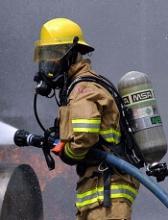Exposure to the 9/11 World Trade Center (WTC) disaster site may increase the risk of monoclonal gammopathy of undetermined significance (MGUS) and early development of multiple myeloma (MM).
Researchers found that firefighters exposed to the site had a nearly 2-fold higher risk of MGUS than a control population.
And those firefighters who developed MM were diagnosed 12 years earlier than MM patients in the general US population.
These findings were published in JAMA Oncology.
Previous studies suggested that MGUS and MM tend to develop after exposure to toxic chemicals, and individuals exposed to the WTC disaster site have an increased risk of developing cancers.
The aerosolized dust from the collapsed WTC towers exposed firefighters and other first responders to high levels of polychlorinated biphenyls, polycyclic aromatic hydrocarbons, dioxins, asbestos, and other potential carcinogens, as well as diesel smoke from heavy machinery used in the 10-month rescue and recovery effort.
“With our 2011 study in The Lancet, we were the first to show that first responders were more likely to get many different types of cancer,” said David J. Prezant, MD, of Albert Einstein College of Medicine in Bronx, New York.
“We carried out this new study to do more than just treat cancer. We wanted to find early, predictive signs of cancer that would allow us to screen people and monitor those found to be at risk. By detecting MGUS, which predicts the development of multiple myeloma, we are able to do that.”
For statistical reasons, the study population was limited to 781 white, male WTC-exposed firefighters ages 50 to 79.
The researchers assess the prevalence of MGUS in these firefighters and compared it to the prevalence of MGUS in a non-exposed comparison group—men living in Olmsted County, Minnesota.
The prevalence of MGUS was 1.8-fold higher in the firefighters. There were 7.63 cases of MGUS per 100 firefighters and 4.34 cases per 100 non-exposed men.
The researchers also found the prevalence of light-chain MGUS was 3.1-fold higher in the firefighters than in the controls. The prevalence rate of light-chain MGUS was 3.08 and 0.98 per 100 persons, respectively.
“We saw a significantly higher incidence of MGUS in these first responders, and they’re developing it at a young age,” said study author Amit Verma, MBBS, of Albert Einstein College of Medicine.
The subjects’ early development of MGUS suggests they may face an increased risk for early onset MM as well.
In a separate analysis, the researchers examined 16 cases of MM among white, male WTC-exposed firefighters diagnosed between September 12, 2001, and July 1, 2017.
Their average age at diagnosis was 57, or 12 years younger than the average age for MM diagnosis in the US.
The researchers also found that 7 of 14 evaluable cases were light-chain MM. They said this is more than double the rate observed in other populations—50% vs 20%.
In the population of firefighters screened for MGUS, 38% (18/47) of those who had MGUS were found to have the light-chain subtype.
The researchers said these findings are of interest because previous research revealed associations between light-chain MM/MGUS and exposure to toxins and chronic immune stimulation.
The team also assessed CD20 expression in a subset of 7 MM patients. Five of these patients (71%) had CD20-positive cells, which is associated with poor prognosis.
Based on these findings, the researchers recommend that physicians screen first responders exposed to the WTC disaster site for MGUS.
“Screening for multiple myeloma risk by testing for MGUS is something we can offer these first responders, which is why this study is important,” Dr Prezant said.


